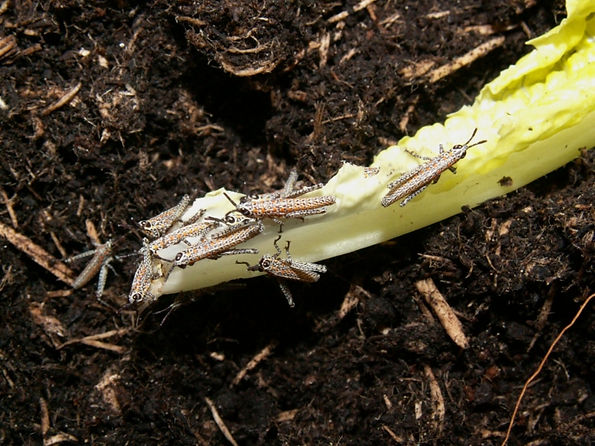-Poekilocerus pictus - Indian Painted Locust





“Poekilocerus pictus belonging to Family Pyrogomorphinae (known for cryptic as well as bright colours hence called Gaudy Grasshoppers are also known for “Spear” shaped heads) is commonly known as Ak Grasshopper (and one of the many Painted Grasshoppers), and is one of the most colorful grasshoppers of India. The nymphs display spots of varied colours from yellow, orange to blue and green. The adults show yellow and blue striped on head and thorax, a bright red abdomen, green-yellow forewings and red hind wings which are seen only in flight. The adults grow to about 60mm and are capable of good flight.
The adults are generally seen post-monsoon and, if conditions are favorable, they swarm. The food plant for this is Calotropis sp., especially C. procera, however it is known to attack many crops (including C. gigantea – Giant Milkweed). The color in nymphs as well as adults is bright and warning and is explained due to the presence of toxic alkaloids present in Calotropis they feed on.
The eggs are laid in “pods” (each pod contains 70 – 200 eggs) during the monsoon months June to August, and the nymphs hatch around September. The nymphs are usually seen near Calotropis plants, and by October the adults are seen specifically on the food plant. I have no records of finding it in the months after monsoon, however literature says that eggs laid in the month of September to November that hatch in April – May, here the incubation period is longer than during monsoon months due to, perhaps, climatic conditions.
According to literature, the adults are also known to turn cannibalistic even in the presence of ample food – for reasons unknown!”
- AULARCHES MILIARIS (LINNAEUS, 1758)
Brief Description
Distribution: tropical Asia (e.g. Pakistan, India, Burma Thailand, Malaysia, Indonesia)
Stock from: Not known
Size: ♂: ca 50mm ♀: ca 70mm
General Care: 25-30°C, 60-80% rel. humidity
Feeding: bramble, rose, oak
Breeding: oviposition into substrate (humus.sand-soil), hatching after 3-5 month Advice/Specifics: if disturbed they secrete a smelly foam (defense) at the sides of the pronotum
- Above the different development stages of AULARCHES MILIARIS
- To the right a AULARCHES MILIARIS on a stamp from indonesia
- Below a dried specimen ..
DUCETIA JAPONICA






Colorful Yellow Spotted Grasshopper Aularches miliaris
-CHROMACRIS PSITTACUS PACIFICUS ROBERTS & CARBONELL, 1982
Brief Description
Distribution: Ecuador, Columbia
Stock from: Ecuador
Size: ♂:♀: ca 40 mm
General Care: 15-34°C, 70-80% rel. humidity
Feeding: Solanacea, Cestrum spp., buddleja (maybe not sufficient on the long term for reproduction etc.)
Breeding: oviposition into substrate (humus-sand-soil), hatching after 3 month
Advice/Specifics: needs sufficient ventilation




- DICTYOPHORUS (TAPESIELLA) GRISEUS (REICHE & FAIRMAIRE, 1849)
Brief Description
Distribution: Africa
Stock from: Tansania (Arusha)
Size: ♂:♀: ca 50 mm
General Care: 25-35°C, 60-70% rel. humidity
Feeding: bramble, Asclepias spp., bittersweet nightshade
Breeding: oviposition into substrate (humus-sand-soil)
Advice/Specifics: roost at night at more protected and humid places (e.g. under bark)





-DICTYOPHORUS SPUMANS (THUNBERG, 1787)





- DUCETIA JAPONICA :




- EUCONOCEPHALUS NASUTUS (THUNBERG, 1815)
still courtesy to : www.saltatoria.info/english/species-a-z/euconocephalus-nasutus/



Due to the large quantity of grasshoppers species and the new yearly discoveries we will shortlisted the famous and most colorful and strange shape of these creatures . yet this hobby is challenging for the most of hobbyists ..
GRASSHOPPER : Introduction and general keeping information
GRASSHOPPER SPECIES : Page One - Page two - Page Three - Page Four
GRASSHOPPER : Introduction and general keeping information
GRASSHOPPER SPECIES : Page One - Page two - Page Three - Page Four